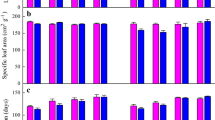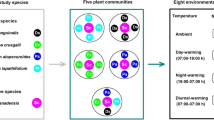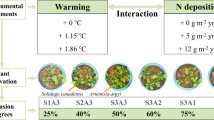Abstract
Many studies have documented the effects of global warming on invasive plants, but little is known about the effects on plant invasion between day and night warming. We tested the impact of day and night warming on seedling growth and the competitive interaction between invasive and native species. Three invasive and three native species in the Asteraceae family were selected. Three warming patterns (day-, night-, and whole-day warming of 3 °C relative to the control) and the control were set in growth chambers. The results showed that night warming increased the root biomass and total biomass of native plants, while it had little effect on invasive plants, and night warming increased the root to shoot ratio of natives to a greater extent than invaders. Day warming increased the maximum net photosynthetic rate of native plants but decreased that of invasive plants, and during the night it increased plant height and respiratory rate of invasive plants to a greater extent than natives. With competition between invasive and native plants, night warming increased competitive suppression of the root growth of native species, but had little effect on the relative interaction intensity of invasive species in terms of root biomass. With the increase in night warming, invasion of the alien species in southern China may be facilitated in the future. Conclusions regarding the effects of future warming should be made cautiously because differences in day and night warming may have different implications for invasion.



Similar content being viewed by others
References
Alward RD, Detling JK, Milchunas DG (1999) Grassland vegetation changes and nocturnal global warming. Science 283:229–231
Armas C, Ordiales R, Pugnaire FI (2004) Measuring plant interactions: a new comparative index. Ecology 85:2682–2686
Bais HP, Vepachedu R, Gilroy S, Callaway RM, Vivanco JM (2003) Allelopathy and exotic plant invasion: from molecules and genes to species interactions. Science 301:1377–1379
Blumenthal DM, Resco V, Morgan JA, Williams DG, LeCain DR, Hardy EM, Pendall E, Bladyka E (2013) Invasive forb benefits from water savings by native plants and carbon fertilization under elevated CO2 and warming. New Phytol 200:1156–1165
Blumenthal DM, Kray JA, Ortmans W, Ziska LH, Pendall E (2016) Cheatgrass is favored by warming but not CO2 enrichment in a semi-arid grassland. Glob Change Biol 22:3026–3038
Bradley BA, Blumenthal DM, Wilcove DS, Ziska LH (2010a) Predicting plant invasions in an era of global change. Trends Ecol Evol 25:310–318
Bradley BA, Wilcove DS, Oppenheimer M (2010b) Climate change increases risk of plant invasion in the Eastern United States. Biol Invasions 12:1855–1872
Büntgen U, Martínez-Peña F, Aldea J, Rigling A, Fischer EM, Camarero JJ, Hayes MJ, Fatton V, Egli S (2013) Declining pine growth in Central Spain coincides with increasing diurnal temperature range since the 1970s. Glob Planet Change 107:177–185
Callaway RM, Ridenour WM (2004) Novel weapons: invasive success and the evolution of increased competitive ability. Front Ecol Environ 2:436–443
Carlen C, Kölliker R, Nösberger J (1999) Dry matter allocation and nitrogen productivity explain growth responses to photoperiod and temperature in forage grasses. Oecologia 121:441–446
Catford JA, Daehler CC, Murphy HT, Sheppard AW, Hardesty BD, Westcott DA, Rejmánek M, Bellingham PJ, Pergl J, Horvitz CC (2012) The intermediate disturbance hypothesis and plant invasions: implications for species richness and management. Perspect Plant Ecol Evol Syst 14:231–241
Chen B-M, Gao Y, Liao H-X, Peng S-L (2017) Differential responses of invasive and native plants to warming with simulated changes in diurnal temperature ranges. AoB Plants 9:plx028–plx028
Chen B-M, Su J-Q, Liao H-X, Peng S-L (2018) A greater foraging scale, not a higher foraging precision, may facilitate invasion by exotic plants in nutrient-heterogeneous conditions. Ann Bot 121:561–569
Chi Y, Xu M, Shen R, Wan S (2013) Acclimation of leaf dark respiration to nocturnal and diurnal warming in a semiarid temperate steppe. Funct Plant Biol 40:1159–1167
Cunze S, Leiblein MC, Tackenberg O (2013) Range expansion of Ambrosia artemisiifolia in Europe is promoted by climate change. ISRN Ecol:610126
Daehler CC (2003) Performance comparisons of co-occurring native and alien invasive plants: implications for conservation and restoration. Annu Rev Ecol Evol Syst 34:183–211
Dukes JS, Mooney HA (1999) Does global change increase the success of biological invaders? Trends Ecol Evol 14:135–139
Ehrenfeld JG (2010) Ecosystem consequences of biological invasions. Annu Rev Ecol Evol Syst 41:59–80
Griffin KL, Turnbull M, Murthy R, Lin G, Adams J, Farnsworth B, Lin G, Adams J, Farnsworth B, Mahato T, Bazin G, Potasnak M, Berry JA (2002) Leaf respiration is differentially affected by leaf vs. stand-level night-time warming. Glob Change Biol 8:479–485
Hellmann JJ, Byers JE, Bierwagen BG, Dukes JS (2008) Five potential consequences of climate change for invasive species. Conserv Biol 22:534–543
Hendrickson L, Furbank RT, Chow WS (2004) A simple alternative approach to assessing the fate of absorbed light energy using chlorophyll fluorescence. Photosynth Res 82:73
Hou Q-Q, Chen B-M, Peng S-L, Chen L-Y (2014) Effects of extreme temperature on seedling establishment of nonnative invasive plants. Biol Invasions 16:2049–2061
Hughes L (2000) Biological consequences of global warming: is the signal already apparent? Trends Ecol Evol 15:56–61
Hulme PE (2009) Relative roles of life-form, land use and climate in recent dynamics of alien plant distributions in the British Isles. Weed Res 49:19–28
Koutsovoulou K, Daws MI, Thanos CA (2014) Campanulaceae: a family with small seeds that require light for germination. Ann Bot 113:135–143
Leffler AJ, James JJ, Monaco TA (2013) Temperature and functional traits influence differences in nitrogen uptake capacity between native and invasive grasses. Oecologia 171:51–60
Li Z, Lin J, Zhang T, Zhang N, Mu C, Wang J (2014) Effects of summer nocturnal warming on biomass production of Leymus chinensis in the Songnen grassland of China: from bud bank and photosynthetic compensation. J Agron Crop Sci 200:66–76
Liu B, Xu M, Henderson M, Qi Y, Li Y (2004) Taking China’s temperature: daily range, warming trends, and regional variations, 1955–2000. J Clim 17:4453–4462
Manea A, Leishman MR (2011) Competitive interactions between native and invasive exotic plant species are altered under elevated carbon dioxide. Oecologia 165:735–744
Maron JL, Elmendorf SC, Vilà M (2007) Contrasting plant physiological adaptation to climate in the native and introduced range of hypericum perforatum. Evolution 61:1912–1924
McCormick AJ, Cramer MD, Watt DA (2006) Sink strength regulates photosynthesis in sugarcane. New Phytol 171:759–770
Ordonez A, Wright IJ, Olff H (2010) Functional differences between native and alien species: a global-scale comparison. Funct Ecol 24:1353–1361
Parker-Allie F, Musil CF, Thuiller W (2009) Effects of climate warming on the distributions of invasive Eurasian annual grasses: a South African perspective. Clim Change 94:87–103
Paul MJ, Foyer CH (2001) Sink regulation of photosynthesis. J Exp Bot 52:1383–1400
Paul M, Pellny T, Goddijn O (2001) Enhancing photosynthesis with sugar signals. Trends Plant Sci 6:197–200
Peng Y, Yang JX, Zhou XH, Peng PH, Li JJ, Zhang SM, He WM (2019) An invasive population of Solidago canadensis is less sensitive to warming and nitrogen-addition than its native population in an invaded range. Biol Invasions 21:151–162
Ryan MG (1991) Effects of climate change on plant respiration. Ecol Appl 1:157–167
Seebens H, Blackburn TM, Dyer EE, Genovesi P, Hulme PE, Jeschke JM et al (2017) No saturation in the accumulation of alien species worldwide. Nat Commun 8:14435
Smith AL, Hewitt N, Klenk N, Bazely DR, Yan N, Wood S, Henriques I, MacLellan JI, Lipsig-Mummé C (2012) Effects of climate change on the distribution of invasive alien species in Canada: a knowledge synthesis of range change projections in a warming world. Environ Rev 20:1–16
Song L, Chow WS, Sun L, Li C, Peng C (2010) Acclimation of photosystem II to high temperature in two Wedelia species from different geographical origins: implications for biological invasions upon global warming. J Exp Bot 61:4087–4096
Turnbull M, Murthy R, Griffin K (2002) The relative impacts of daytime and night-time warming on photosynthetic capacity in Populus deltoides. Plant Cell Environ 25:1729–1737
Van Kleunen M, Weber E, Fischer M (2010) A meta-analysis of trait differences between invasive and non‐invasive plant species. Ecol Lett 13:235–245
Verlinden M, Nijs I (2010) Alien plant species favoured over congeneric natives under experimental climate warming in temperate Belgian climate. Biol Invasions 12:2777–2787
Vilà M, Espinar JL, Hejda M, Hulme PE, Jarošík V, Maron JL, Pergl J, Schaffner U, Sun Y, Pyšek P (2011) Ecological impacts of invasive alien plants: a meta-analysis of their effects on species, communities and ecosystems. Ecol Lett 14:702–708
Walther G-R, Roques A, Hulme PE, Sykes MT, Pyšek P, Kühn I, Zobel M, Bacher S, Botta-Dukát Z, Bugmann H, Czúcz B, Dauber J, Hickler T, Jarošík V, Kenis M, Klotz S, Minchin D, Moora M, Nentwig W, Ott J, Panov VE, Reineking B, Robinet C, Semenchenko V, Solarz W, Thuiller W, Vilà M, Vohland K, Settele J (2009) Alien species in a warmer world: risks and opportunities. Trends Ecol Evol 24:686–693
Wan S, Xia J, Liu W, Niu S (2009) Photosynthetic overcompensation under nocturnal warming enhances grassland carbon sequestration. Ecology 90:2700–2710
Wang RL, Zeng RS, Peng SL, Chen BM, Liang XT, Xin XW (2011) Elevated temperature may accelerate invasive expansion of the liana plant Ipomoea cairica. Weed Res 51:574–580
Wang D, Heckathorn SA, Wang X, Philpott SM (2012) A meta-analysis of plant physiological and growth responses to temperature and elevated CO2. Oecologia 169:1–13
Wang J, Zhang Q, Song J, Ru J, Zhou Z, Xia J, Dukes JS, Wan S (2020) Nighttime warming enhances ecosystem carbon-use efficiency in a temperate steppe. Funct Ecol 34:1721–1730
Went FW (1953) The effect of temperature on plant growth. Annu Rev Plant Physiol 4:347–362
Williams AL, Wills KE, Janes JK, Vander Schoor JK, Newton PCD, Hovenden MJ (2007) Warming and free-air CO2 enrichment alter demographics in four co-occurring grassland species. New Phytol 176:365–374
Wolkovich EM, Cleland EE (2014) Phenological niches and the future of invaded ecosystems with climate change. AoB Plants 6:plu013
Xia J, Chen J, Piao S, Ciais P, Luo Y, Wan S (2014) Terrestrial carbon cycle affected by non-uniform climate warming. Nat Geosci 7:173–180
Xu Z-Z, Zhou G-S (2005a) Effects of water stress and high nocturnal temperature on photosynthesis and nitrogen level of a perennial grass Leymus chinensis. Plant Soil 269:131–139
Xu Z-Z, Zhou G-S (2005b) Effects of water stress and nocturnal temperature on carbon allocation in the perennial grass, Leymus chinensis. Physiol Plant 123:272–280
You Q, Kang S, Aguilar E, Pepin N, Flügel W-A, Yan Y, Xu Y, Zhang Y, Huang J (2011) Changes in daily climate extremes in China and their connection to the large scale atmospheric circulation during 1961–2003. Clim Dyn 36:2399–2417
Zhang Q, Zhang Y, Peng S, Zobel K (2014) Climate warming may facilitate invasion of the exotic shrub Lantana camara. PLoS ONE 9:e105500
Acknowledgements
The study was supported by the National Natural Science Foundation of China (31670479) and the Natural Science Foundation of Guangdong Province (2016A030313287). We thank Dr. Hui-Xuan Liao for feedback during the data analysis.
Author information
Authors and Affiliations
Corresponding author
Ethics declarations
Conflict of interest
The authors declare no conflict of interest.
Additional information
Publisher's Note
Springer Nature remains neutral with regard to jurisdictional claims in published maps and institutional affiliations.
Electronic Supplementary Material
Below is the link to the electronic supplementary material.
Rights and permissions
About this article
Cite this article
Su, JQ., Han, X. & Chen, BM. Do day and night warming exert different effects on growth and competitive interaction between invasive and native plants?. Biol Invasions 23, 157–166 (2021). https://doi.org/10.1007/s10530-020-02362-x
Received:
Accepted:
Published:
Issue Date:
DOI: https://doi.org/10.1007/s10530-020-02362-x




